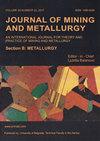从LiFePO4/LiMn2O4混合废锂离子电池正极材料中回收Li、Mn、Fe
IF 1
4区 材料科学
Q3 METALLURGY & METALLURGICAL ENGINEERING
Journal of Mining and Metallurgy Section B-Metallurgy
Pub Date : 2023-01-01
DOI:10.2298/jmmb220918002w
引用次数: 0
摘要
从废旧锂离子电池正极材料中回收金属具有重要的环境和经济意义。本研究采用酸浸分步沉淀法从混合正极材料LiFePO4/LiMn2O4中分离回收锂、铁、锰。用Eh-pH图分析了锂、铁和锰金属相的热力学特征,特别是稳定区。硫酸和双氧水浸出体系从正极材料中释放出Fe3+、Mn2+和Li+离子。浸出液中的Fe3+以Fe(OH)3的形式析出,煅烧后最终以Fe2O3的形式回收。浸出液中的Mn2+被回收为MnCO3。剩余的富Li+溶液蒸发结晶成Li2CO3。回收产品的MnCO3和Li2CO3纯度均达到锂离子电池正极材料的标准。XRD和XPS分析表明,浸出渣中主要物相为FePO4。该工艺可用于从混合废锂离子电池正极材料中分离回收金属,也为锂离子电池正极材料的制备提供原料。本文章由计算机程序翻译,如有差异,请以英文原文为准。
Recovery of Li, Mn, and Fe from LiFePO4/LiMn2O4 mixed waste lithium-ion battery cathode materials
The recovery of metals from used lithium-ion battery cathode materials is of both environmental and economic importance. In this study, acid leaching stepwise precipitation was used to separate and recover lithium, iron, and manganese from the mixed cathode material LiFePO4/LiMn2O4. The thermodynamic characteristics of lithium, iron, and manganese metal phases, especially the stability region, were analyzed by Eh-pH diagrams. The sulfuric acid and hydrogen peroxide leaching system released Fe3+, Mn2+, and Li+ ions from the cathode material. Fe3+ in the leaching solution was precipitated as Fe(OH)3 and finally recovered as Fe2O3 after calcination. Mn2+ in the leaching solution was recovered as MnCO3. The remaining Li+-rich solution was evaporated and crystallized into Li2CO3. The purity of the recycled products MnCO3 and Li2CO3 met the standard of cathode materials for lithium-ion batteries. XRD and XPS analysis showed that the main phase in the leaching residue was FePO4. This process can be used to separate and recover metals from mixed waste lithium-ion battery cathode materials, and it also provides raw materials for the preparation of lithium-ion battery cathode materials.
求助全文
通过发布文献求助,成功后即可免费获取论文全文。
去求助
来源期刊
CiteScore
2.00
自引率
40.00%
发文量
19
审稿时长
2 months
期刊介绍:
University of Belgrade, Technical Faculty in Bor, has been publishing the journal called Journal of Mining and Metallurgy since 1965 and in 1997 it was divided in two independent journals dealing with mining and metallurgy separately. Since 2009 Journal of Mining and Metallurgy, Section B: Metallurgy has been accepted in Science Citation Index Expanded.
Journal of Mining and Metallurgy, Section B: Metallurgy presents an international medium for the publication of contributions on original research which reflect the new progresses in theory and practice of metallurgy. The Journal covers the latest research in all aspects of metallurgy including hydrometallurgy, pyrometallurgy, electrometallurgy, transport phenomena, process control, solidification, mechanical working, solid state reactions, materials processing, surface treatment and relationships among processing, structure, and properties of materials.

 求助内容:
求助内容: 应助结果提醒方式:
应助结果提醒方式:


